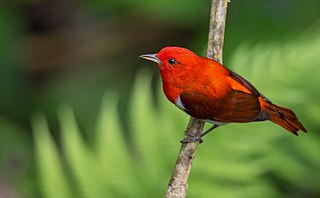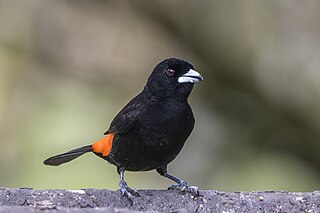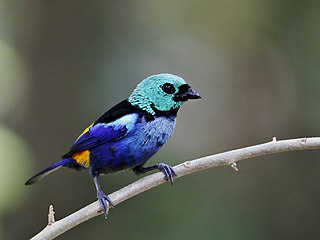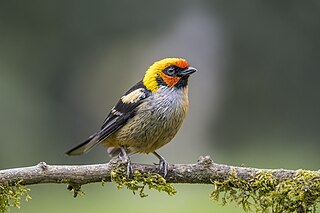
The scarlet tanager is a medium-sized American songbird. Until recently, it was placed in the tanager family (Thraupidae), but it and other members of its genus are now classified as belonging to the cardinal family (Cardinalidae). The species' plumage and vocalizations are similar to other members of the cardinal family, although the Piranga species lacks the thick conical bill that many cardinals possess. The species resides in thick deciduous woodlands and suburbs.

The silver-beaked tanager is a medium-sized passerine bird. This tanager is a resident breeder in South America from eastern Colombia and Venezuela south to Paraguay and central Brazil, Peru and on Trinidad. It is common and conspicuous.

The crimson-collared tanager is a rather small Middle American songbird. It was first described by the French naturalist René-Primevère Lesson in 1831, its specific epithet from the Latin adjective sanguinolentus, "bloodied", referring to its red plumage.

The scarlet-rumped tanager is a medium-sized passerine bird. This tanager is a resident breeder in the Caribbean lowlands from southern Mexico to western Panama. This species was formerly known as the scarlet-rumped tanager, but was renamed to Passerini's Tanager after Carlo Passerini, a professor at the Museum of Zoology of the University of Florence, when the distinctive form found on the Pacific coast of Costa Rica and Panama was reclassified as a separate species, the Cherrie's tanager, Ramphocelus costaricensis. While most authorities had accepted this split, there were notable exceptions. It was renamed back to the scarlet-rumped tanager in 2018 when Cherrie's Tanager was lumped back into the species.

Cherrie's tanager is a medium-sized passerine bird. This tanager is a resident breeder in the Pacific lowlands of Costa Rica and western Panama. This bird was formerly known as the scarlet-rumped tanager, but was split as a separate species from the Caribbean form, which was itself renamed as Passerini's tanager, Ramphocelus passerinii. While most authorities had accepted this split, there were notable exceptions. It was lumped back into the Scarlet-rumped Tanager in 2018.

The golden-chested tanager is a species of bird in the family Thraupidae. It is found in Colombia and Ecuador. Its natural habitats are subtropical or tropical moist lowland forests and subtropical or tropical moist montane forests.

The yellow-green tanager is a species of bird in the family Thraupidae. It was formerly known as the yellow-green bush tanager or yellow-green chlorospingus as it used to be placed in the genus Chlorospingus with other bush tanagers. Chlorospingus as a whole was formerly placed in the tanager family Thraupidae, but was transferred to the New World sparrows when genetic analysis of two Chlorospingus species revealed they were embedded within the latter family. However, more recently, molecular analysis of additional Chlorospingus species found that the yellow-green tanager is not a member of Chlorospingus but a true tanager after all, most closely related to the blue-and-gold tanager, so the species was returned to Thraupidae and placed in the genus Bangsia.

The scarlet-and-white tanager is a species of bird in the family Thraupidae. It is found in Colombia and northern Ecuador. Its natural habitats are subtropical or tropical moist lowland forests and heavily degraded former forest. The male is highly distinctive and has bright scarlet upperparts, darker red wings and undertail coverts, and white underparts with a scarlet median stripe running down the throat and belly. Females are patterned like the males, but are olive-brown instead of scarlet.

The Brazilian tanager is a species of bird in the family Thraupidae. It is endemic to eastern Brazil and far northeastern Argentina, occurring in the coastal region from Paraíba and southwards to Santa Catarina and Misiones.

The crimson-backed tanager is a species of bird in the family Thraupidae. It is found in Colombia, Panama, and Venezuela, and introduced to French Polynesia. Its natural habitats are subtropical or tropical moist lowland forests and heavily degraded former forest. A nickname in Panama is sangre de toro.

The flame-rumped tanager is a species of bird in the family Thraupidae. It is found in semi-open forest and woodland.

The masked crimson tanager is a species of bird in the family Thraupidae. It is found in Bolivia, Brazil, Colombia, Ecuador, and Peru. Its natural habitats are subtropical or tropical swamps and subtropical or tropical moist shrubland.

The seven-colored tanager is a vulnerable species of bird in the family Thraupidae. It is endemic to forests in north-eastern Brazil. It resembles the overall greener green-headed tanager; a species confusingly known as the seven-coloured tanager (saíra-sete-cores) in Portuguese.

The flame-faced tanager is a species of bird in the tanager family Thraupidae. It is endemic to South America and is found in the eastern Andes of Colombia, Ecuador, Peru and Venezuela. Its natural habitat is subtropical or tropical moist montane forests. It is a distinctive-looking species with black and opalescent green upperparts, opalescent green and buff underparts, and a deep red and yellow face. The subspecies lunigera lacks the deep red on the face, which is replaced with orangish-red.

The chestnut-backed tanager is a species of bird in the family Thraupidae. It is found in southern Brazil, north-eastern Argentina, eastern Paraguay, and Uruguay in mature forests up to 1000m elevation. It is closely related to the rarer black-backed tanager, which have identical plumage except for the males' mantle. Females of the two species are virtually indistinguishable by plumage. This bird is characterized by its blue-green breast and chestnut back. It was previously considered a color morph of the black-backed tanager ; however, Stilpnia is not known to have polymorphism, and the two species have different habitat preferences and breeding range. The tanager is reported as fairly common in part of its range and unlikely to face any particular threats; as a result, the IUCN has listed it as being of Least Concern.

The saffron-crowned tanager is a species of bird in the family Thraupidae. Found in the northern Andes of Bolivia, Colombia, Ecuador, Peru, and Venezuela, it inhabits cloud forest, forest edges, and secondary forest, preferring areas with mossy trees. It is an average-sized species of tanager with a blue-green body and yellow head with a black forecrown, lores, orbital area, and chin.

The blue-and-yellow tanager is a species of bird in the tanager family Thraupidae.

Ramphocelus is a Neotropical genus of birds of the tanager family. They have enlarged shiny whitish or bluish-grey lower mandibles, which are pointed upwards in display. However, this is greatly reduced in the females of most species. Males are black and red, orange or yellow, while females resemble a duller version of the males, or are brownish or greyish combined with dull red, orange or yellowish.

Cymbopetalum mayanum is a species of plant in family Annonaceae. The specific epithet mayanum refers to the Mayan region in which it is indigenous, specifically the Atlantic lowlands of Guatemala and Honduras. It grows as a tree. It is endangered due to habitat loss from agriculture.

The lemon-rumped tanager is a species of bird in the family Thraupidae. It is sometimes considered a subspecies of the flame-rumped tanager. It is found from Panama to Ecuador. Its natural habitats are subtropical or tropical moist lowland forests and heavily degraded former forest.






















